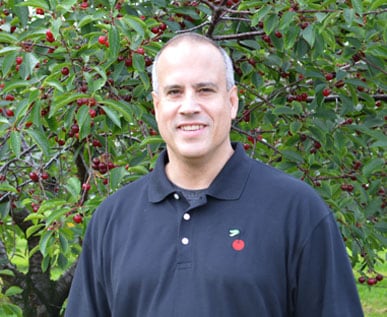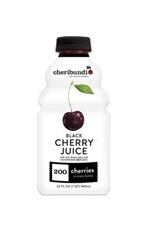The beverage’s appeal is its athletic recovery benefits. “Some Wall Street guys were playing tennis and started to feel muscle pain, and I think it was one of their grandmothers who said they should eat tart cherries,” Steve Pear, Cheribundi’s CEO, told FoodNavigator-USA.
The Cornell Chronicle documented Cheribundi’s conception back in 2006. Long story short, the tennis-playing stockbroker John Davey got in touch with Cornell food scientist Olga Padilla-Zakour, and the two developed Cheribundi’s predecessor, CherryPharm, which is made through a process that “retains the highest amount of anthocyanins, the antioxidants in tart cherries that attack the COX enzymes in your body that cause inflammation,” Pear said.
Keeping the Cornell affiliation

“Our plant sits on the Tech Farm which is managed by Cornell in Geneva, New York,” Pear said. “We’re still kind of connected to the university. The chairman of our board teaches the entrepreneur studies at Cornell.”
Cheribundi’s enduring connection to the university makes sense. It was Dr. Padilla-Zakour’s studies, together with two other scientists from the Nicholas Institute of Sports Medicine and Athletic Trauma, and the University of Vermont’s Human Performance Lab, published in the British Journal of Sports Medicine in June 2006 that garnered a lot attention of tart cherry’s efficacy for recovery in athletes.
“Their research, published in the British Journal of Sports Medicine in June, showed strength loss was 22 percent with a placebo versus only 4 percent with the cherry juice. Trainers of athletes who have tried the drink say it works,” the Cornell Chronicle reported.
Not quite competitors
In a way, Cheribundi’s competitors aren’t quite their competitors, as Pear said that their products are quite different. “It’s not the normal type of the competition I’m used to, from when I worked for the Coca-Cola company for example,” Pear said. “Our competitors both use concentrate product, and we’re not from concentrate, and it’s one of 30 flavors that they have.”
In comparison, Cheribundi releases just cherry products. Cherries are sourced from farms in New York and Michigan, and are juiced stateside, while its competitors get their cherries from ovreseas, and processing could be anywhere.
A line out of necessity
The tart cherry juice products are Cheribundi’s main line. The “original” has 200 cherries in 32fl oz, and a light version has 160 cherries and less sugar in the same size bottle. The black cherry juice product is also gaining a lot of demand, and Walmart reached out to Cheribundi in 2014 for an exclusive launch at their stores.

The two tart cherry products come in 8fl oz bottles as well. In addition, the 8fl oz come with two performance-related variations. “Rebuild” has 8g of added whey protein in it, while the “Relax” has added L-Theanine.
“Our Rebuild is the most popular one ordered by athletic teams,” Pear said. “I would describe that as more of a ‘hardcore’ protein drink, so we’re in the works of launching a more mainstream protein drink.”
Two additional lines, “Fruit Refresh” and “Tea Refresh,” were created during a bad crop year in 2012. “The cherry harvest got really hurt by the bad weather,” Pear said. “So we had to come up with ideas for great products that use less cherry.”
When Steve Pear came on board as CEO in 2013, the beverage was mostly sold online or in the natural food channel. Today, Cheribundi can be found in major retailers. “We have plans for national distribution in the next couple months,” Pear said.
